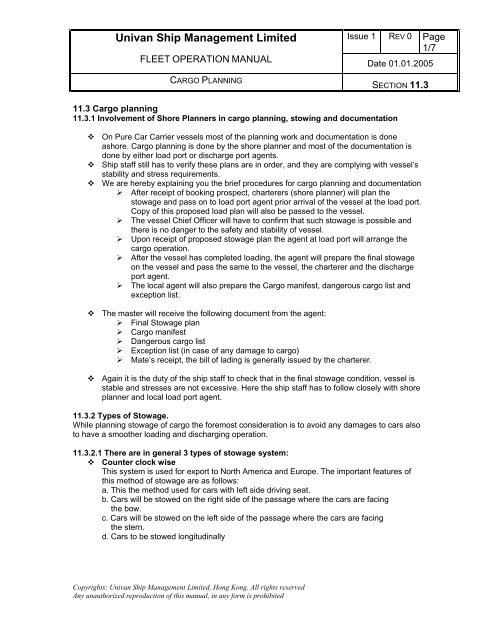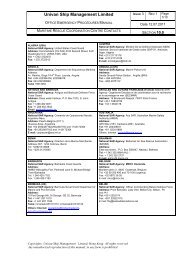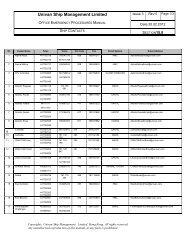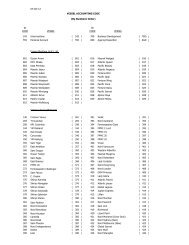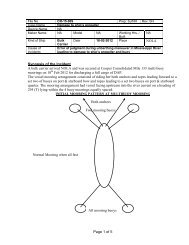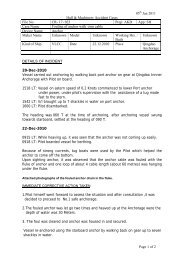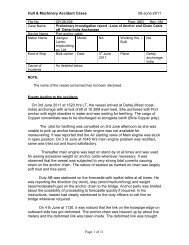Section: 11 CARGO OPERATIONS - Univan
Section: 11 CARGO OPERATIONS - Univan
Section: 11 CARGO OPERATIONS - Univan
You also want an ePaper? Increase the reach of your titles
YUMPU automatically turns print PDFs into web optimized ePapers that Google loves.
<strong>Univan</strong> Ship Management Limited Issue 1 REV 0 Page<br />
1/7<br />
FLEET OPERATION MANUAL Date 01.01.2005<br />
<strong>CARGO</strong> PLANNING<br />
<strong>11</strong>.3 Cargo planning<br />
<strong>11</strong>.3.1 Involvement of Shore Planners in cargo planning, stowing and documentation<br />
Copyrights: <strong>Univan</strong> Ship Management Limited, Hong Kong. All rights reserved<br />
Any unauthorized reproduction of this manual, in any form is prohibited<br />
SECTION <strong>11</strong>.3<br />
On Pure Car Carrier vessels most of the planning work and documentation is done<br />
ashore. Cargo planning is done by the shore planner and most of the documentation is<br />
done by either load port or discharge port agents.<br />
Ship staff still has to verify these plans are in order, and they are complying with vessel’s<br />
stability and stress requirements.<br />
We are hereby explaining you the brief procedures for cargo planning and documentation<br />
After receipt of booking prospect, charterers (shore planner) will plan the<br />
stowage and pass on to load port agent prior arrival of the vessel at the load port.<br />
Copy of this proposed load plan will also be passed to the vessel.<br />
The vessel Chief Officer will have to confirm that such stowage is possible and<br />
there is no danger to the safety and stability of vessel.<br />
Upon receipt of proposed stowage plan the agent at load port will arrange the<br />
cargo operation.<br />
After the vessel has completed loading, the agent will prepare the final stowage<br />
on the vessel and pass the same to the vessel, the charterer and the discharge<br />
port agent.<br />
The local agent will also prepare the Cargo manifest, dangerous cargo list and<br />
exception list.<br />
The master will receive the following document from the agent:<br />
Final Stowage plan<br />
Cargo manifest<br />
Dangerous cargo list<br />
Exception list (in case of any damage to cargo)<br />
Mate’s receipt, the bill of lading is generally issued by the charterer.<br />
Again it is the duty of the ship staff to check that in the final stowage condition, vessel is<br />
stable and stresses are not excessive. Here the ship staff has to follow closely with shore<br />
planner and local load port agent.<br />
<strong>11</strong>.3.2 Types of Stowage.<br />
While planning stowage of cargo the foremost consideration is to avoid any damages to cars also<br />
to have a smoother loading and discharging operation.<br />
<strong>11</strong>.3.2.1 There are in general 3 types of stowage system:<br />
Counter clock wise<br />
This system is used for export to North America and Europe. The important features of<br />
this method of stowage are as follows:<br />
a. This the method used for cars with left side driving seat.<br />
b. Cars will be stowed on the right side of the passage where the cars are facing<br />
the bow.<br />
c. Cars will be stowed on the left side of the passage where the cars are facing<br />
the stern.<br />
d. Cars to be stowed longitudinally


